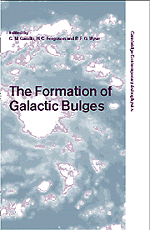Book contents
- Frontmatter
- Contents
- Preface
- Dedication: In Memory of Olin Eggen
- Part 1 Introduction
- Part 2 The Epoch of Bulge Formation
- Part 3 The Timescales of Bulge Formation
- Constraints on the Bulge Formation Timescale from Stellar Populations
- Bulge Building with Mergers and Winds
- Role of Winds, Starbursts, and Activity in Bulge Formation
- Dynamical Timescales of Bulge Formation
- Part 4 Physical Processes in Bulge Formation
- Part 5 Bulge Phenomenology
- Part 6 Conference Summary
- Index
Bulge Building with Mergers and Winds
from Part 3 - The Timescales of Bulge Formation
Published online by Cambridge University Press: 10 November 2010
- Frontmatter
- Contents
- Preface
- Dedication: In Memory of Olin Eggen
- Part 1 Introduction
- Part 2 The Epoch of Bulge Formation
- Part 3 The Timescales of Bulge Formation
- Constraints on the Bulge Formation Timescale from Stellar Populations
- Bulge Building with Mergers and Winds
- Role of Winds, Starbursts, and Activity in Bulge Formation
- Dynamical Timescales of Bulge Formation
- Part 4 Physical Processes in Bulge Formation
- Part 5 Bulge Phenomenology
- Part 6 Conference Summary
- Index
Summary
The gravitational clustering hierarchy and dissipative gas processes are both involved in the formation of bulges. Here I present a simple empirical model in which bulge material is assembled via gravitational accretion of visible companion galaxies. Assuming that merging leads to a starburst, I show that the resulting winds can be strong enough to self-regulate the accretion. A quasi-equilibrium accretion process naturally leads to the Kormendy relation between bulge density and size. Whether or not the winds are sufficiently strong and long lived to create the quasi-equilibrium must be tested with observations. To illustrate the model I use it to predict representative parameter-dependent star formation histories. The bulge building activity appears to peak around a redshift z ∼ 2, with tails to both higher and lower redshifts.
Introduction
Bulges are stellar dynamical pressure supported systems that generally have much higher surface brightnesses than galactic disks. They therefore have undergone more collapse than galactic disks, evidently with the angular momentum barrier removed. Galaxy merging is an inevitable process that redistributes any pre-merger stars into a physically dense, but phase density lowered, pressure supported distribution. Stellar dynamical mergers produce objects with flattenings largely unrelated to their rotation. In the presence of gas, merging is empirically associated with an often dramatic rise in star formation. These new stars that are formed in place almost certainly reflect the chemical history and the dynamical state of the growing bulge.
- Type
- Chapter
- Information
- The Formation of Galactic Bulges , pp. 64 - 75Publisher: Cambridge University PressPrint publication year: 2000
- 1
- Cited by



